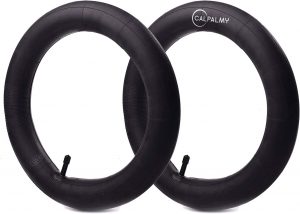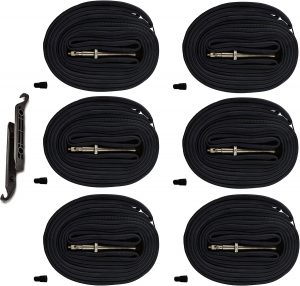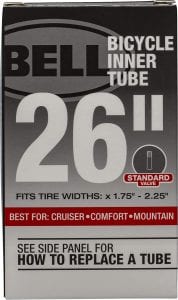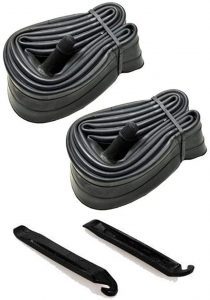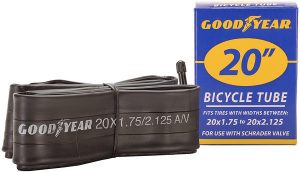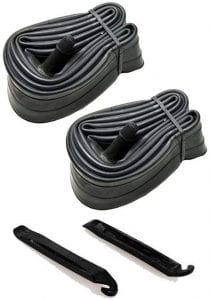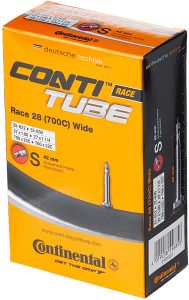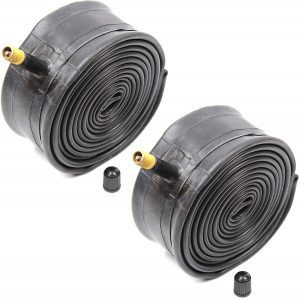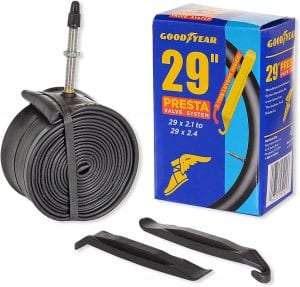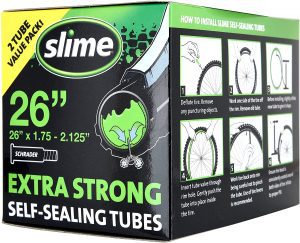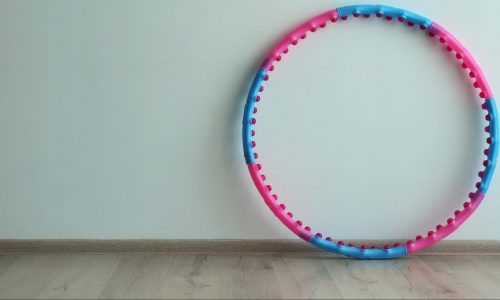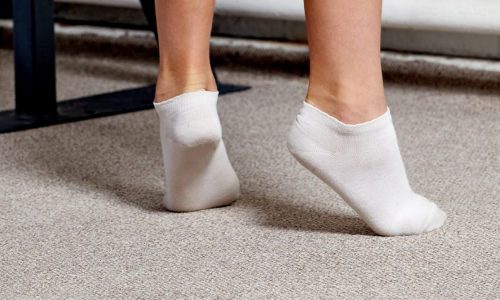The Best Bike Tube
We looked at the top 10 Bike Tubes and dug through the reviews from 10 of the most popular review sites including and more. The result is a ranking of the best Bike Tubes.
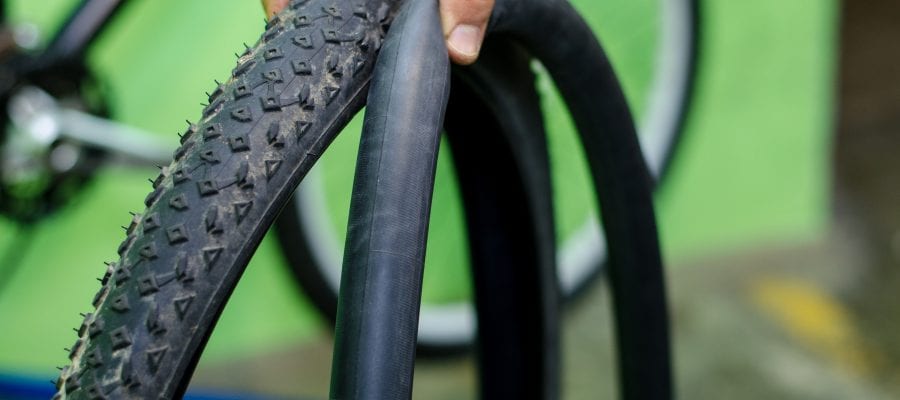
Our Review Process
Don't Waste Your Money is focused on helping you make the best purchasing decision. Our team of experts spends hundreds of hours analyzing, testing, and researching products so you don't have to. Learn more.
Our Picks For The Top Bike Tubes
- 1. CALPALMY Rubber Children’s Bike Tubes, 2-Pack
- 2. AR-PRO Shock Absorbing Reinforced Bike Tubes, 25-Pack
- 3. Bell Cruiser & Mountain Bike Tube
- 4. SCK Wide Compatibility Cruiser Bike Tubes, 2-Pack
- 5. Goodyear Rubber Schrader Valve Bike Tube
- 6. SCK Heat Resistant Bike Tubes Set, 2-Pack
- 7. Continental Rubber Unitube Bike Tube
- 8. Kenda Inner Mountain Bike Tubes, 2-Pack
- 9. Goodyear Presta French Valve Bike Tube
- 10. Slime Extra Strong Non-Toxic Bike Tubes, 2-Pack
You'll find this bike tube is designed to fit kids' bikes that use 12-inch tires with a width between 1.75 and 1.95 inches. Each of the two included tires are constructed using a thick butyl rubber, which does an excellent job of absorbing shocks. That means your little one will enjoy a smoother and safer ride.
Fits Kids' BicyclesSince this bike tube is designed to create an air-tight seal when punctured, it's an excellent choice for safety-conscious parents.
Adults with bicycles that utilize 28-inch tires with a width between 20 to 25 inches will want to consider these bike tubes. They are made using a weather-proof rubber that is extra thick and durable. The brass valves are also reinforced, so you won't have to worry about air leaking out during your ride.
Stock UpYou won't need any tools to install this bike tube, which can be ready to go in just 5 minutes.
Avoid any high-pressure blowouts with these mold-cured rubber inner tubes. They are reliably tested and work well for cruiser and mountain bike tires.
Prevents High-Pressure Blow OutsThese bike tubes are self-sealing with a standard Schrader valve.
It's always best to be prepared, which is why you'll want to have this bike tube set on hand. The set includes two tubes that fit 26-inch bicycles. Each is made from a heat-resistant high butyl rubber that also does an excellent job of retaining air, so your tire doesn't go flat prematurely.
Easy to InstallIncluded with this bike tube set are two complimentary tire levers.
Buying Guide
If you’re experiencing issues with your bike tires, you may be thinking about getting a new bike tube. This is the part of the bike tire that actually holds the air and keeps your tire inflated. It is made of soft, pliable rubber. There is a small air valve on the tube which is where air goes in and out. The inner tube is protected and encased by the actual bike tire, which is made from a firm rubber casing. The bike tire ensures that any small items like glass, nails and debris do not puncture the inner tube. If the inner bike tube does get punctured, then it can be patched or replaced.
The most important element to check when buying a bike tube is the size. You’ll need to know the diameter of your wheel, in addition to the width of your tire, in order to pick the right sized bike tube. Typically your bike tire will have these dimensions on them, often written as diameter times width. If your bike tire says 24 x 1.75, for example, it means that the diameter of your bike tire is 24 inches and the width is 1.75 inches. Knowing this will help you select the right inner tube for your bike.
While you need to know the exact diameter of your bike, you don’t necessarily need to match the width of your bike tire exactly. This is because inner tubes are flexible and often serve a range of sizes when it comes to width. For example, the packaging may note that the inner tube will fit 1.75-2.125-inch tires. This means that you can safely use this inner tube if the width of your tire falls into that range. However, when it comes to diameter, you need to use the exact same measurement as your bike tire.
Why we recommend these bike tubes?
Products Considered
Products Analyzed
Expert Reviews Included
User Opinions Analyzed
Our experts reviewed the top 10 Bike Tubes and also dug through the reviews from 10 of the most popular review sites including and more. The result is a ranking of the best of the best Bike Tubes.
DWYM is your trusted roduct review source. Our team reviews thousands of product reviews from the trusted top experts and combines them into one easy-to-understand score. Learn more.
The Best Bang For Your Buck
Bell Cruiser & Mountain Bike Tube
Key Takeawy
Avoid any high-pressure blowouts with these mold-cured rubber inner tubes. They are reliably tested and work well for cruiser and mountain bike tires.
What other experts liked
What other experts didn't like
What to Look For
- Be sure to select the right valve stem for the bike tube. This is the part of the wheel that enables air to go into the bike tube. There are three common types of valve stems: Schrader, Presta and Woods. The most common type of valve stem you’ll find is the Schrader, and this is found on most recreational bikes. The Presta valve stem is more professional in nature and tends to be used on bikes for competitive cyclists. The Woods valve stem is quite rare; it’s usually found on bikes in the Netherlands and some parts of Asia.
- The material of the bike’s inner tube affects its durability. Typically, tubes are made from butyl or latex. Butyl is a common and affordable option, and is available in multiple different sizes. Keep in mind that this material is heavier than latex and can cause rolling resistance. This kind of material is easy to patch and repair. Latex is a lighter option and causes less friction. However, it is also more costly, and can be fragile in some cases. It is more difficult to patch and repair as well.
More to Explore
In bicycles, the tubes work together with the rim of the tire to seal in air. You may notice that your bike tires differ from car tires — and also lose air more readily. As bike tires are much smaller and lighter than car tires, they are more prone to punctures and leaks. Using tubes allows you to replace the inner tube easily and cheaply compared to installing a new tire whenever that happens.
Car tires actually also had inner tubes until the 1950s, and some buses, trucks and motorcycle tires still do. Tubeless bicycles are now also available, but bicycles with inner tubes remain the most popular.

